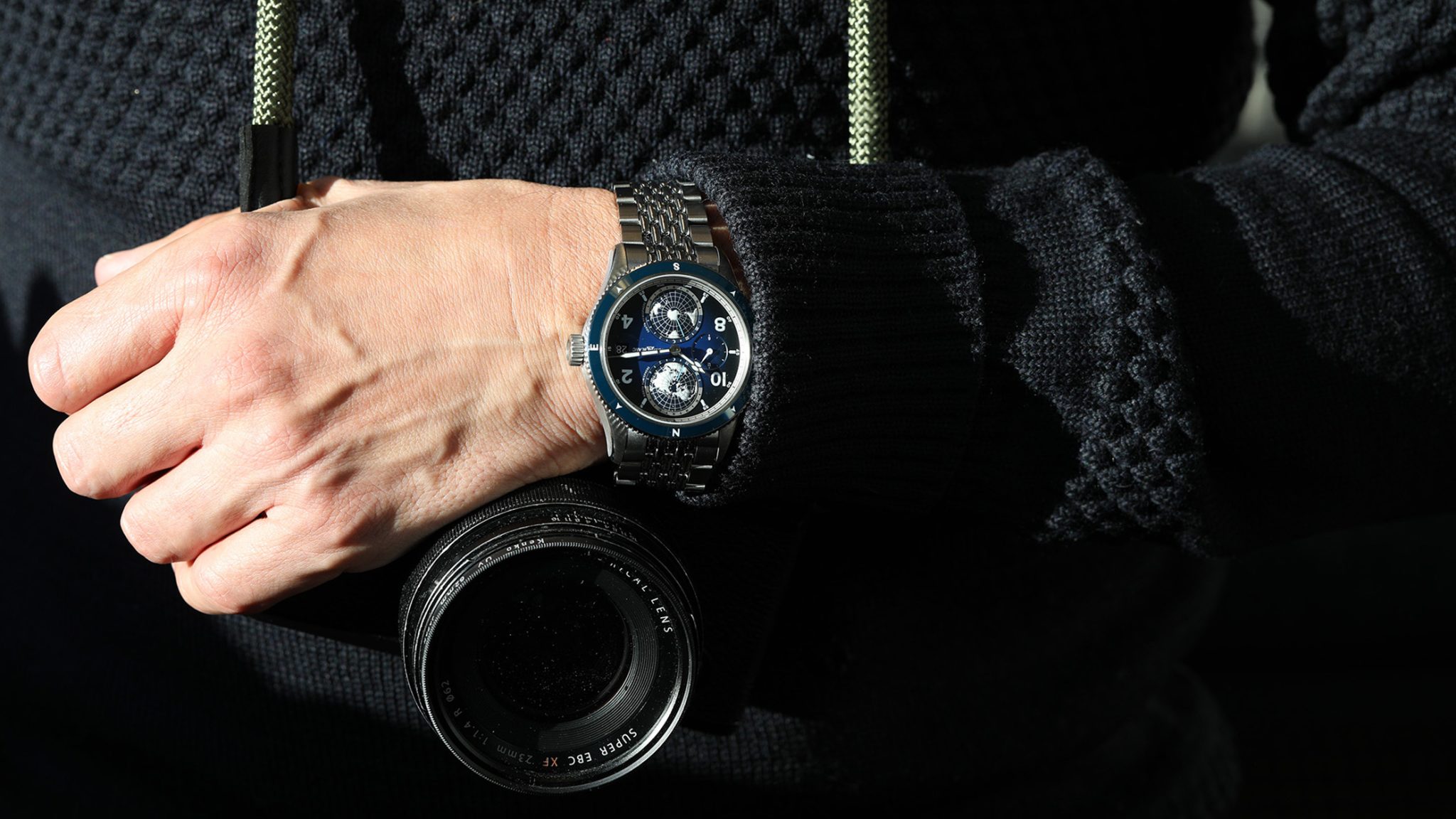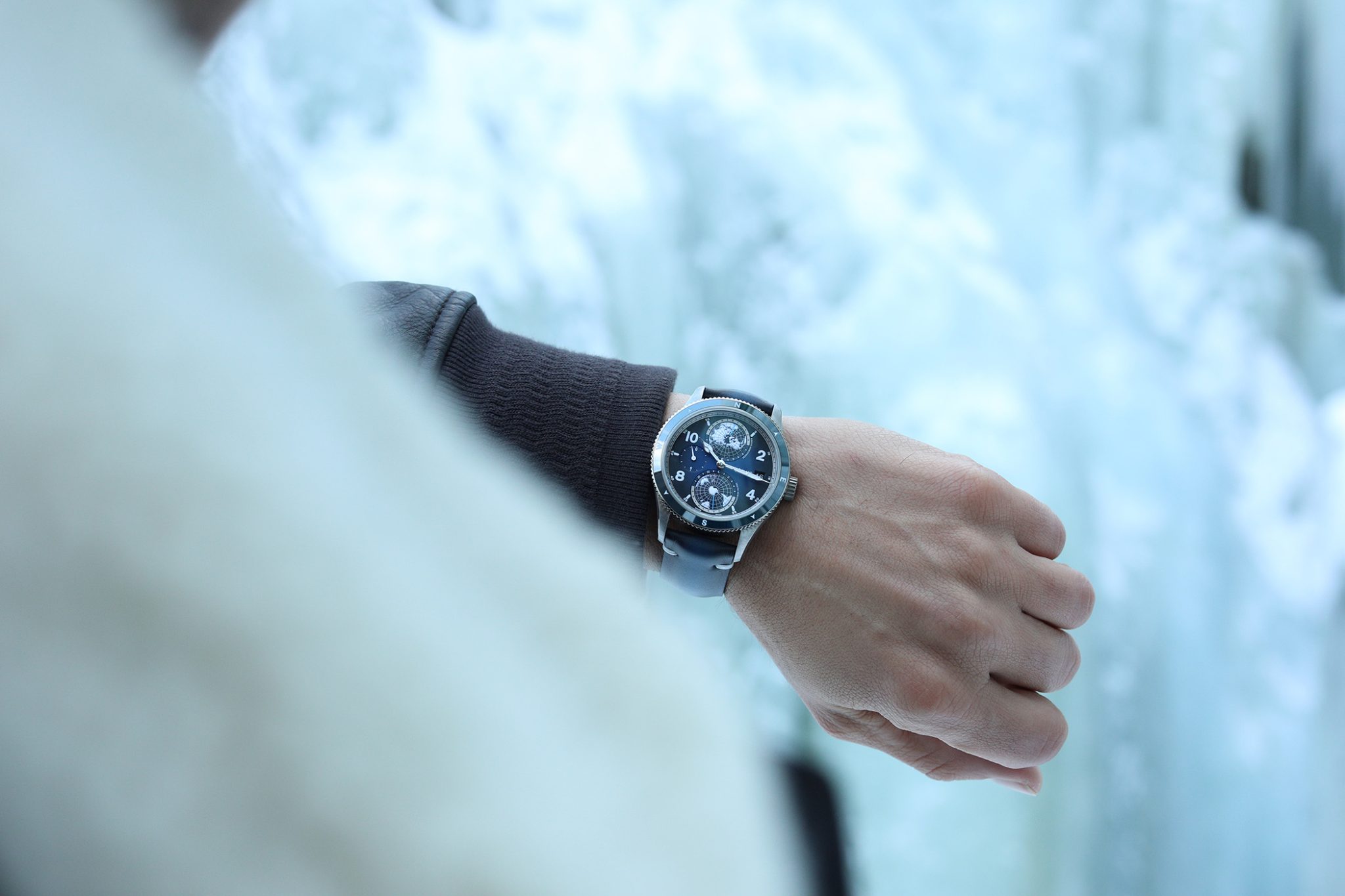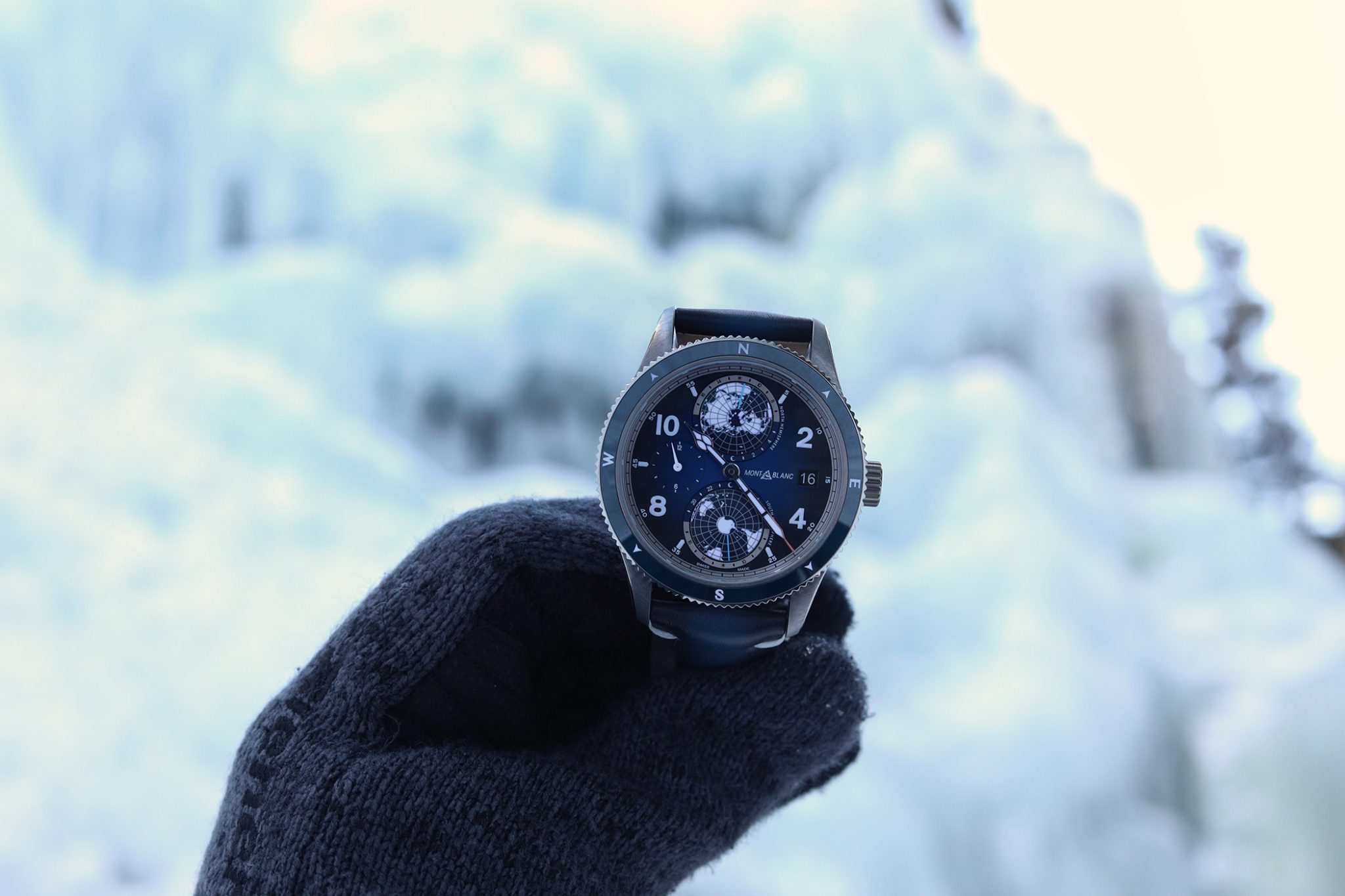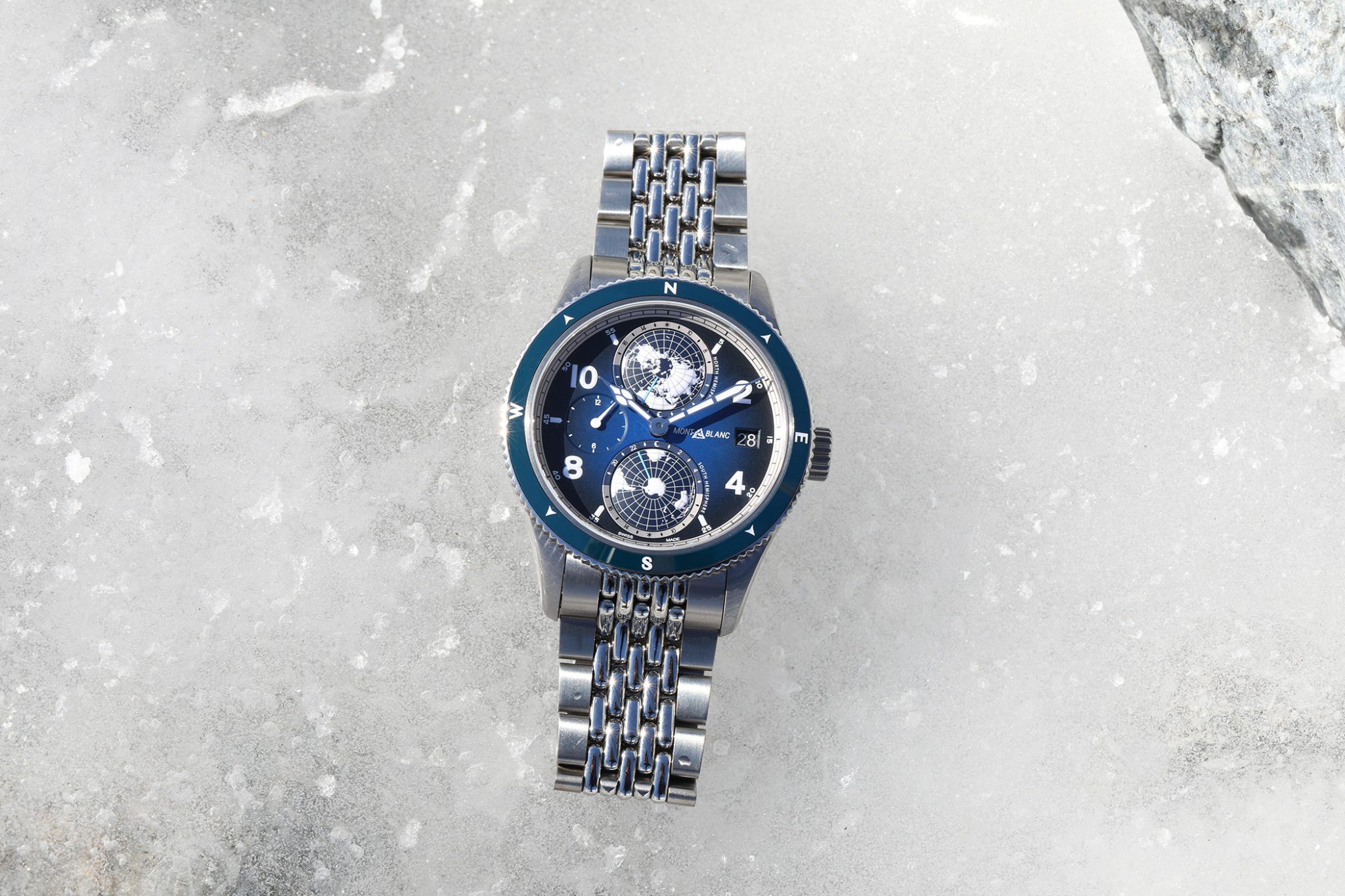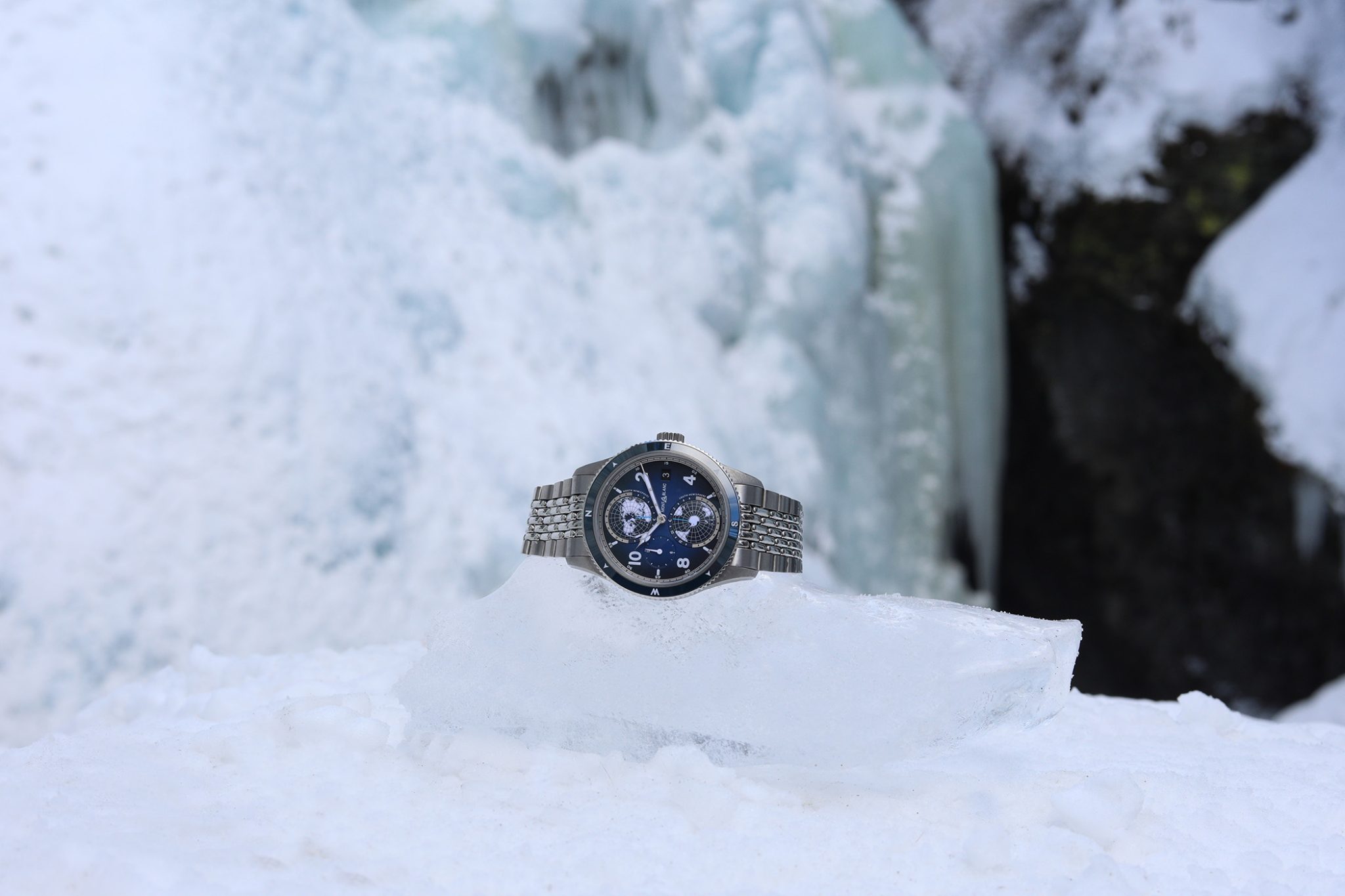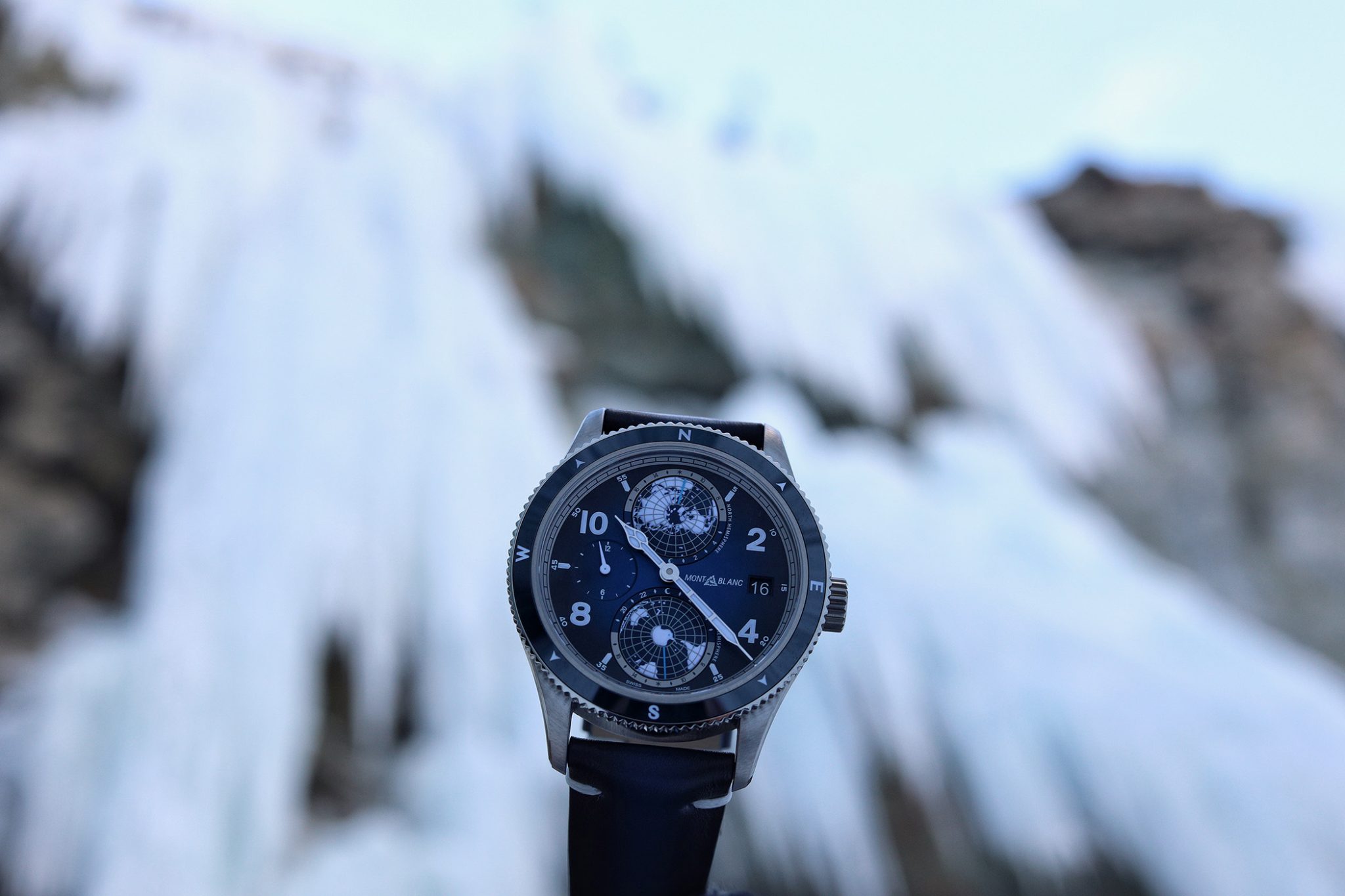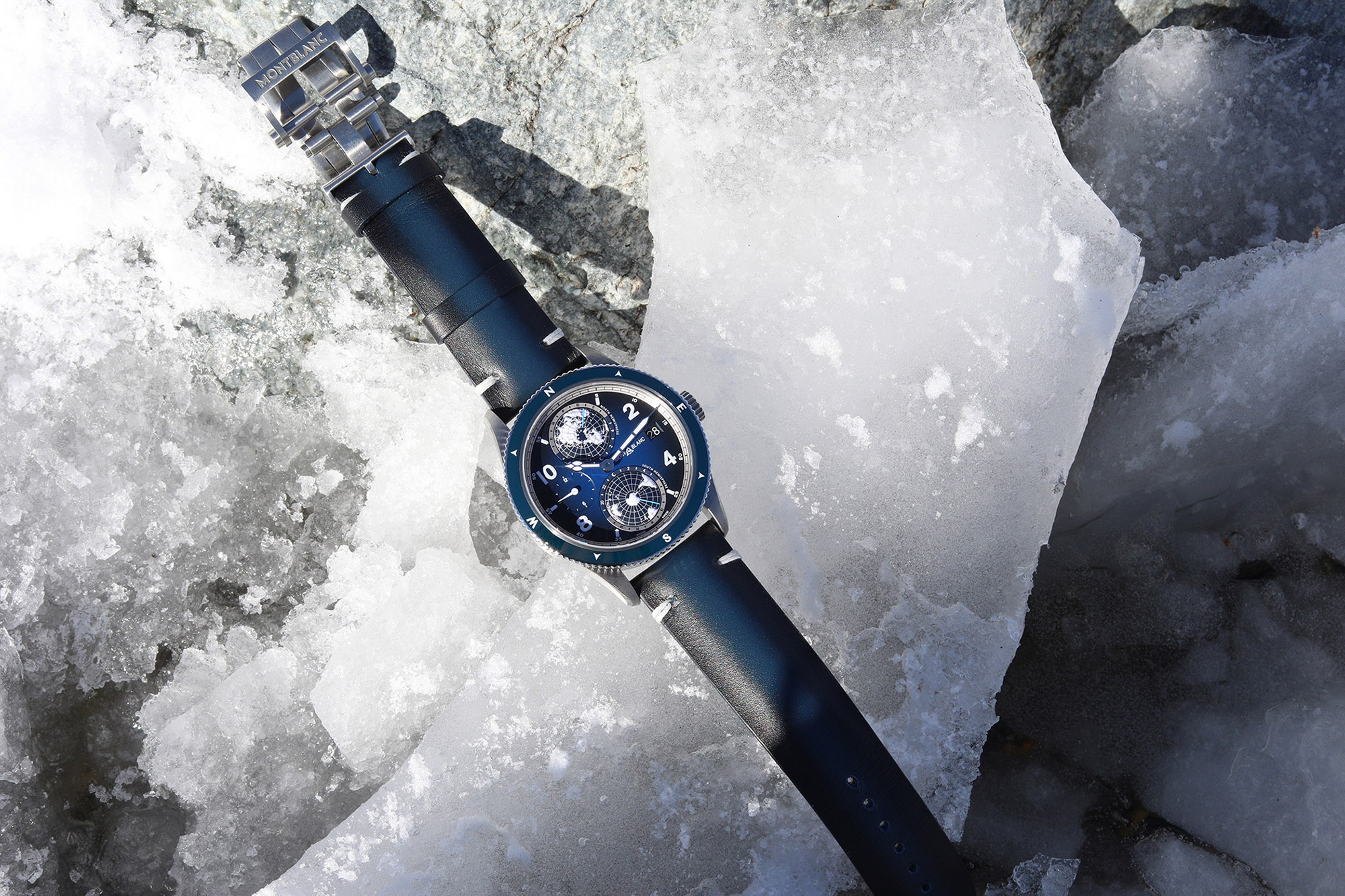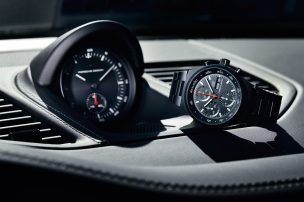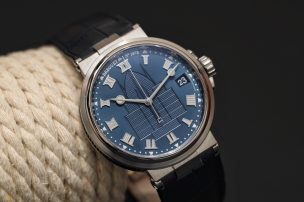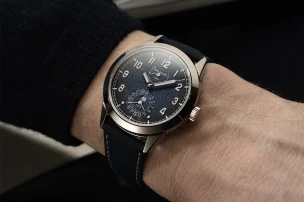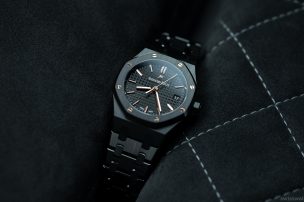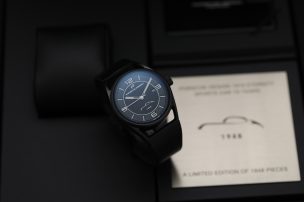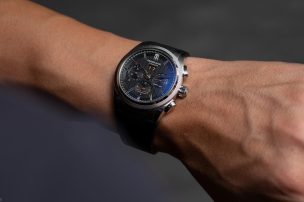
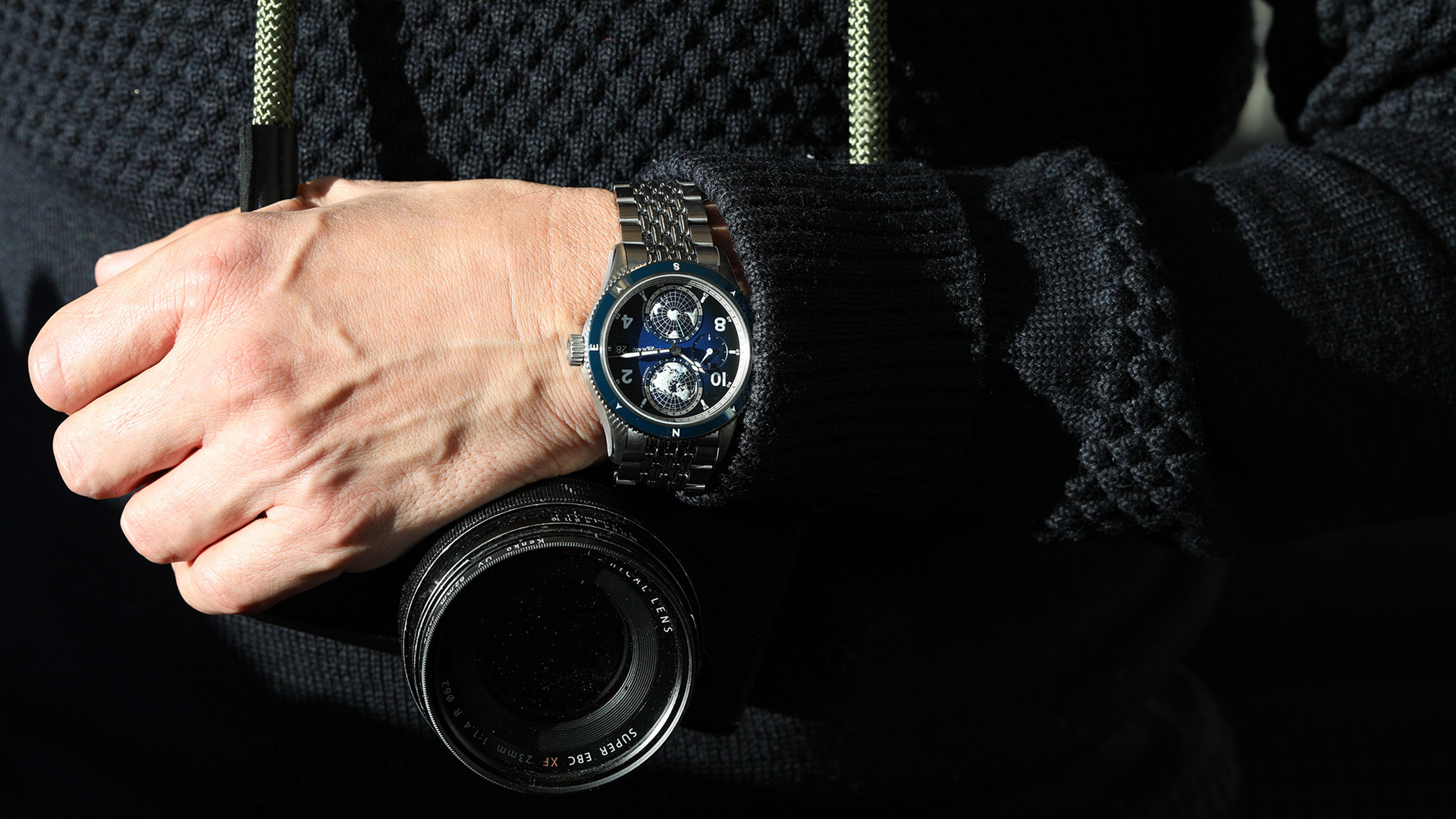
The New Mountaineers of Montblanc – 1858 Split Second Chronograph and Geosphere in Vibrant Blue
It is one of the biggest privileges of our time: To have space to ourselves. To enjoy the wideness. To become one with nature, rather than bumping into masses of people in an overcrowded city. This is how life was long before the current world crisis, and will probably become an even bigger and more popular desire after, when streets will become busier than ever.
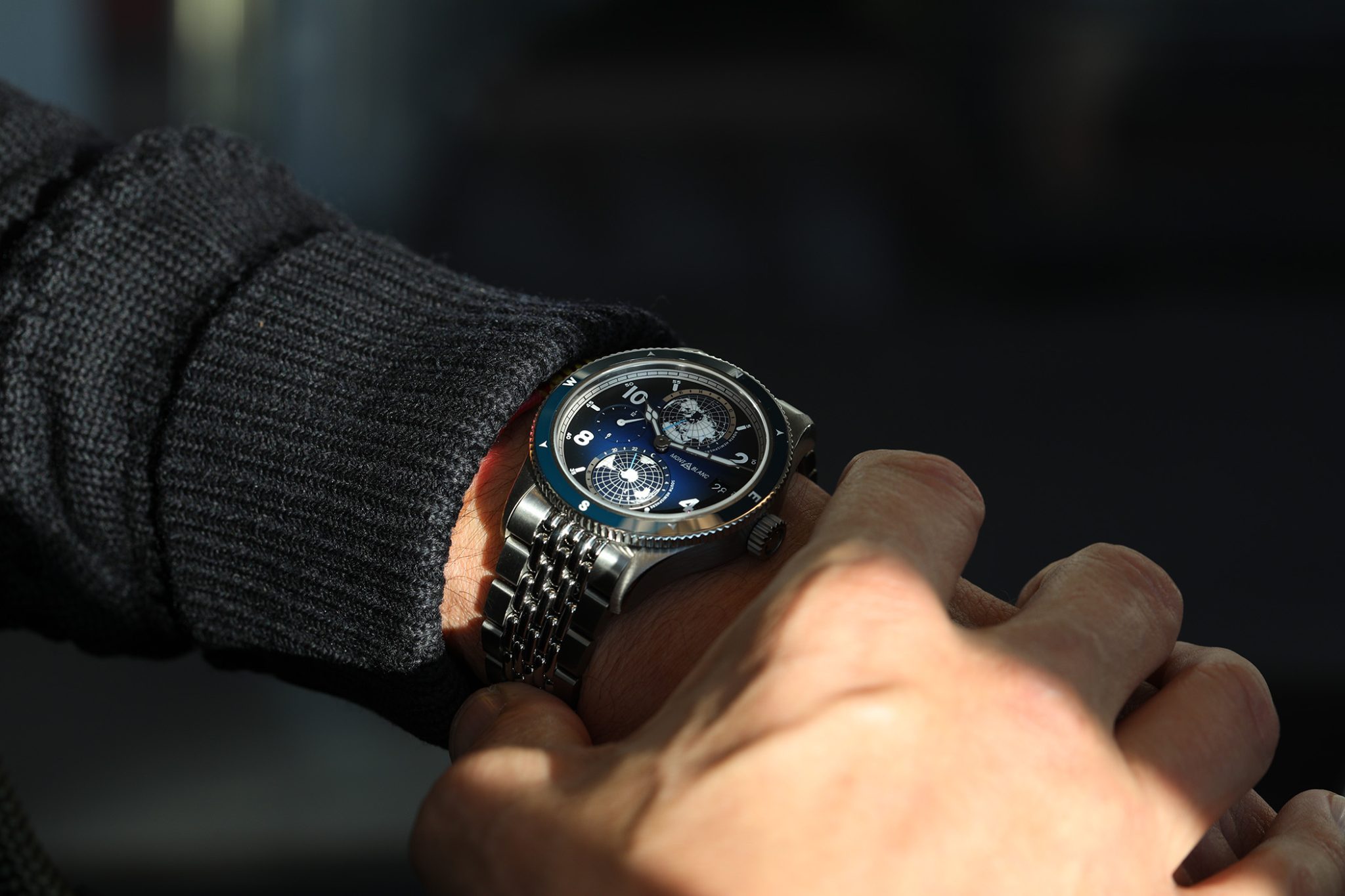
Montblanc 1858 Geosphere
Despite their vintage style, the latest models of Montblanc’s 1858 line perfectly fit the current zeitgeist and the longing for our own space. The watches are not only inspired by the long tradition of the Montblanc-owned Minerva manufacture, but also by the spirit of discovery of mountaineers and explorers. Both of the new 1858 models are equipped with extremely well-executed, vibrant blue dials. Putting the current trend of blue dials aside, the blueness ultimately aims to symbolically bring the infinite vastness of the sky and the cosmos to our wrists.
A rarity – 1858 Split Second Chronograph Limited Edition 100
This model is already well-known to Montblanc fans. Last year, the brand presented a version with a bronze case and black dial that was also strictly limited to 100 pieces. Both the opportunity to observe the movement through the sapphire caseback and the overall design clearly excited many more potential clients, as the horology house has now created another chance to get hold of this extraordinary watch – in a brand new guise.
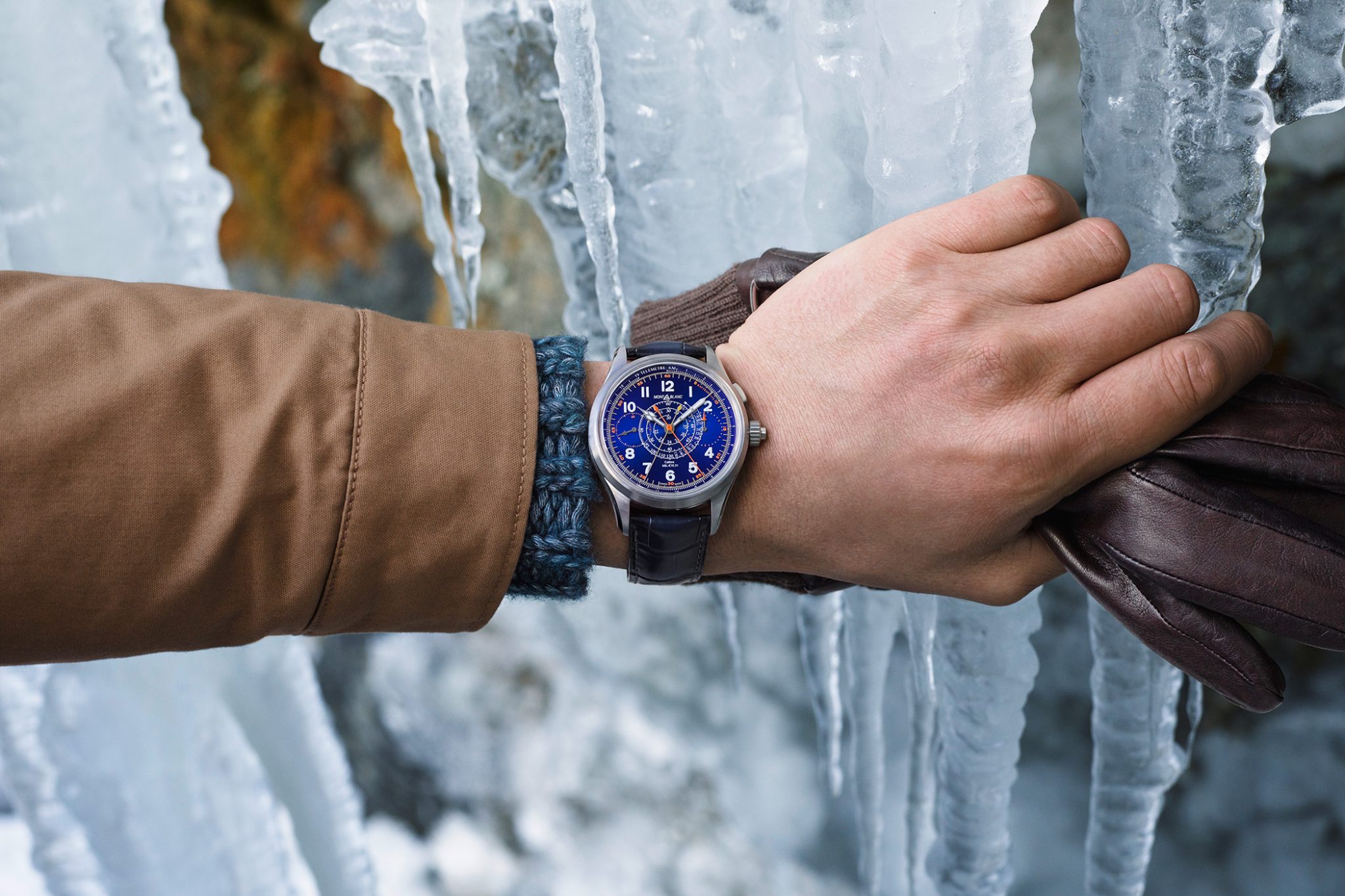
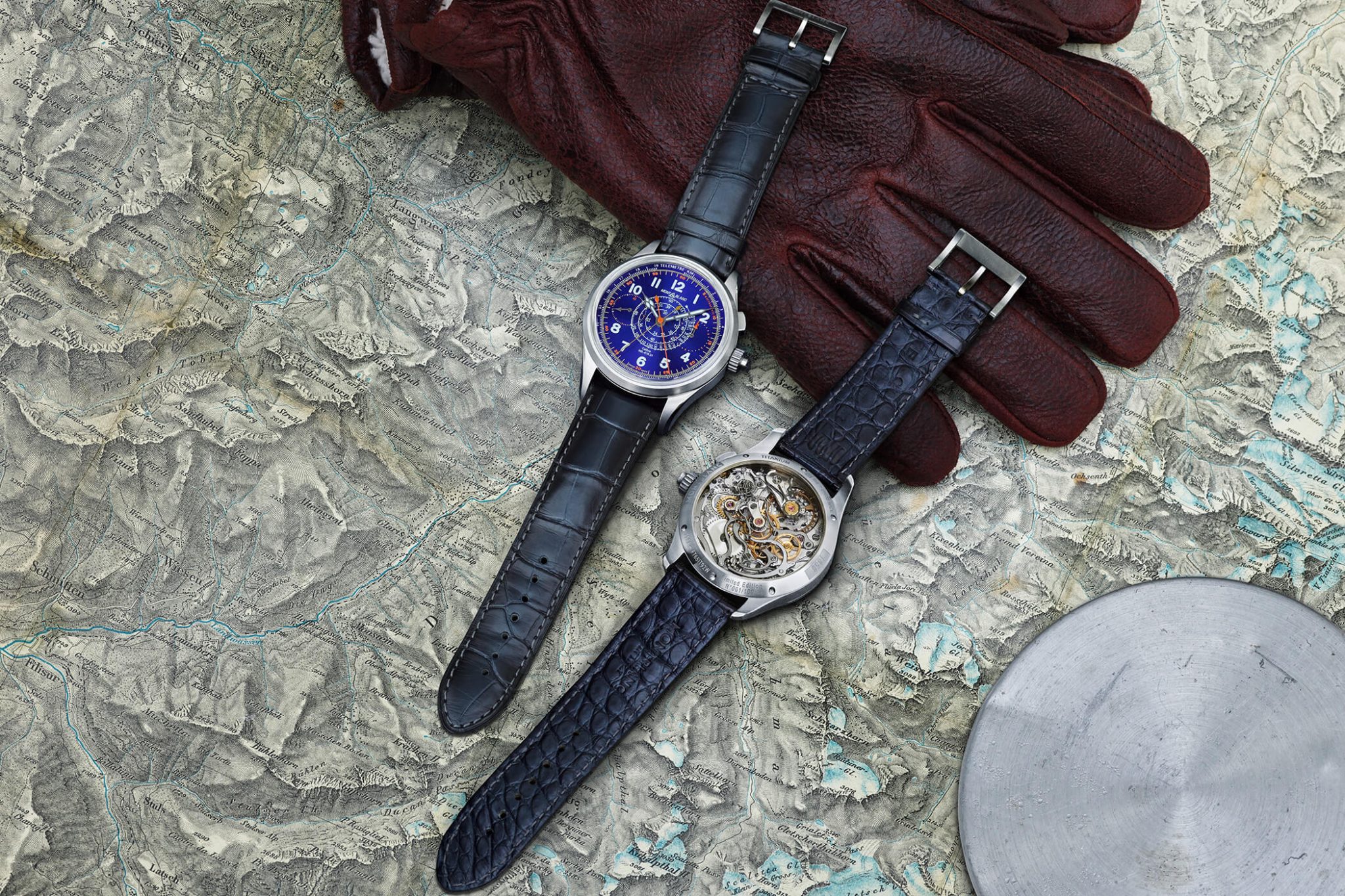

Montblanc’s new Split Second Chronograph in Blue
There is good reason for Montblanc to be proud about the prowess of Minerva. The collection’s name, 1858, reminds us of the foundation of the manufacture, with which Montblanc can now attribute over 160 years of expertise in the creation of chronometers. Secondly, there is the appearance of the timepiece. The dial’s design is inspired by Minerva chronometers from the 1920s and 1930s and has two scales, with each of them offering a different feature to the wearer.
Telemeter scale – essential for mountaineers
The telemeter scale is the more unusual of these two features. It measures the distance between a visible and an audible event, for example lightning and thunder. Following a flash of lightning, you can start timing with your chronograph. Upon hearing a clap of thunder, you stop it. The scale then tells its wearer the distance of the event – in this case, how near the approaching storm is. Additionally, as a second information source, the watch has a tachymeter scale at the centre of the dial, allowing for classic chronograph measurements such as the speed of a car.
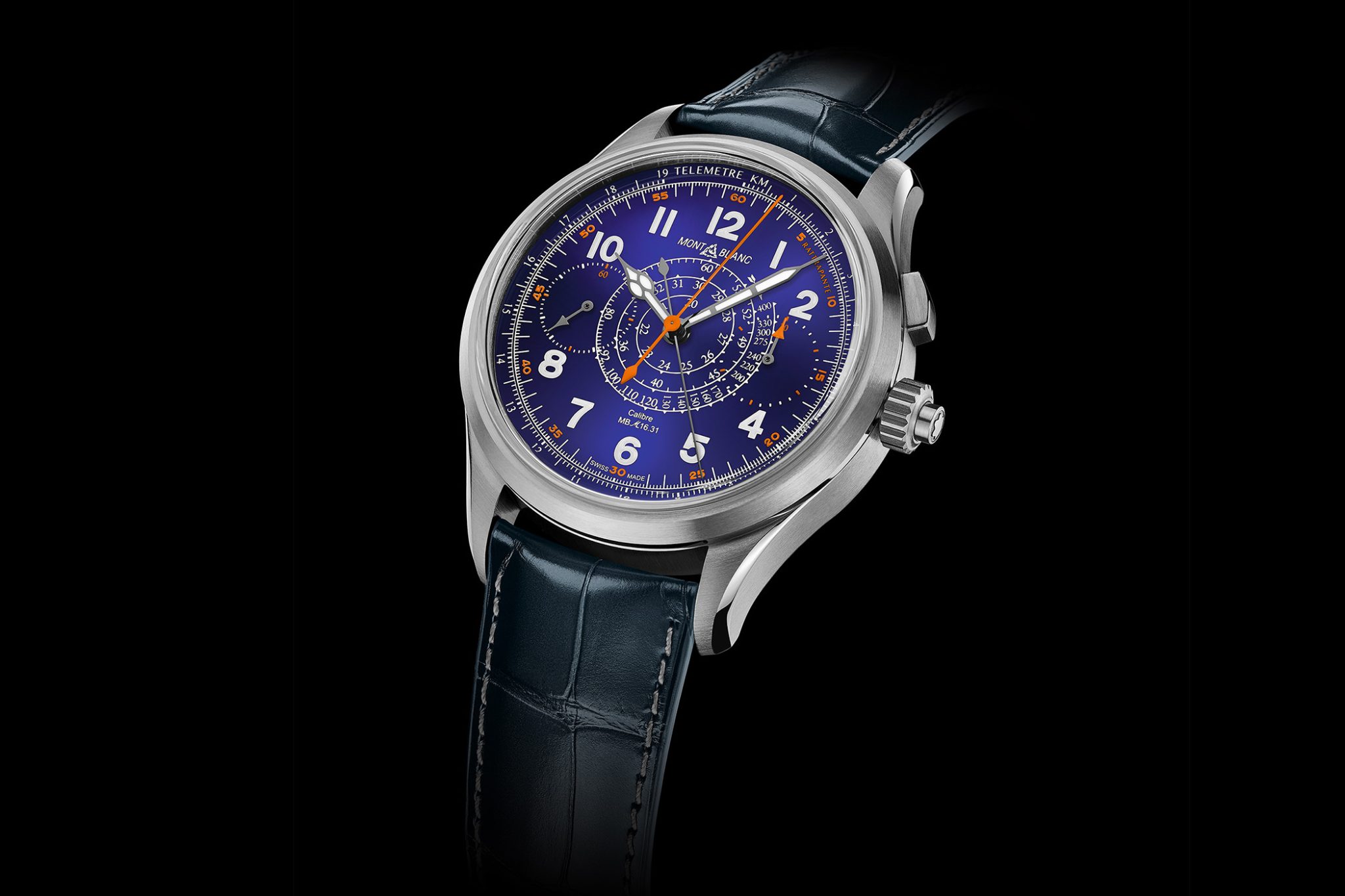
Montblanc 1858 Split Second Chronograph Limited Edition 100
All of this is not only practical, but also highly sophisticated in terms of its design. The blue dial – made of solid gold – is treated with several layers of Grand-Feu-Enamel, creating graduated shades of blue and an impressive depth of colour. Furthermore, the design is enhanced by beige Arabic numerals and indices with Super-LumiNova coating and orange features. This is all framed by a Grade-5-titanium case. This titanium alloy is widely used in aviation and space travel. It has a higher tensile strength than pure titanium and a reduced ductility, meaning it does not bend under heavy weight. It’s also lightweight and has a darker, more technical look and feel than a steel case, for example.
Split Second Chronograph – the holy grail of watchmaking
The watch’s hand-wound movement is as equally fundamental to the timepiece as its enticing appearance. The movement is none other than the monopusher split second chronograph calibre MB M16.31 with a second column wheel, horizontal coupling and a V-shaped bridge. This design was patented back in 1912 by Minerva and mainly used for pocket- and wristwatches (then equipped with Minerva calibre 17.29). Besides the fact that this movement is spectacular to observe and offers a power reserve of 50 hours, split second chronographs that allow to stop intermediate times are considered the holy grail (amongst others) in the watchmaking world. Therefore, it is especially important to pay attention to the inner virtues of this finely finished movement.
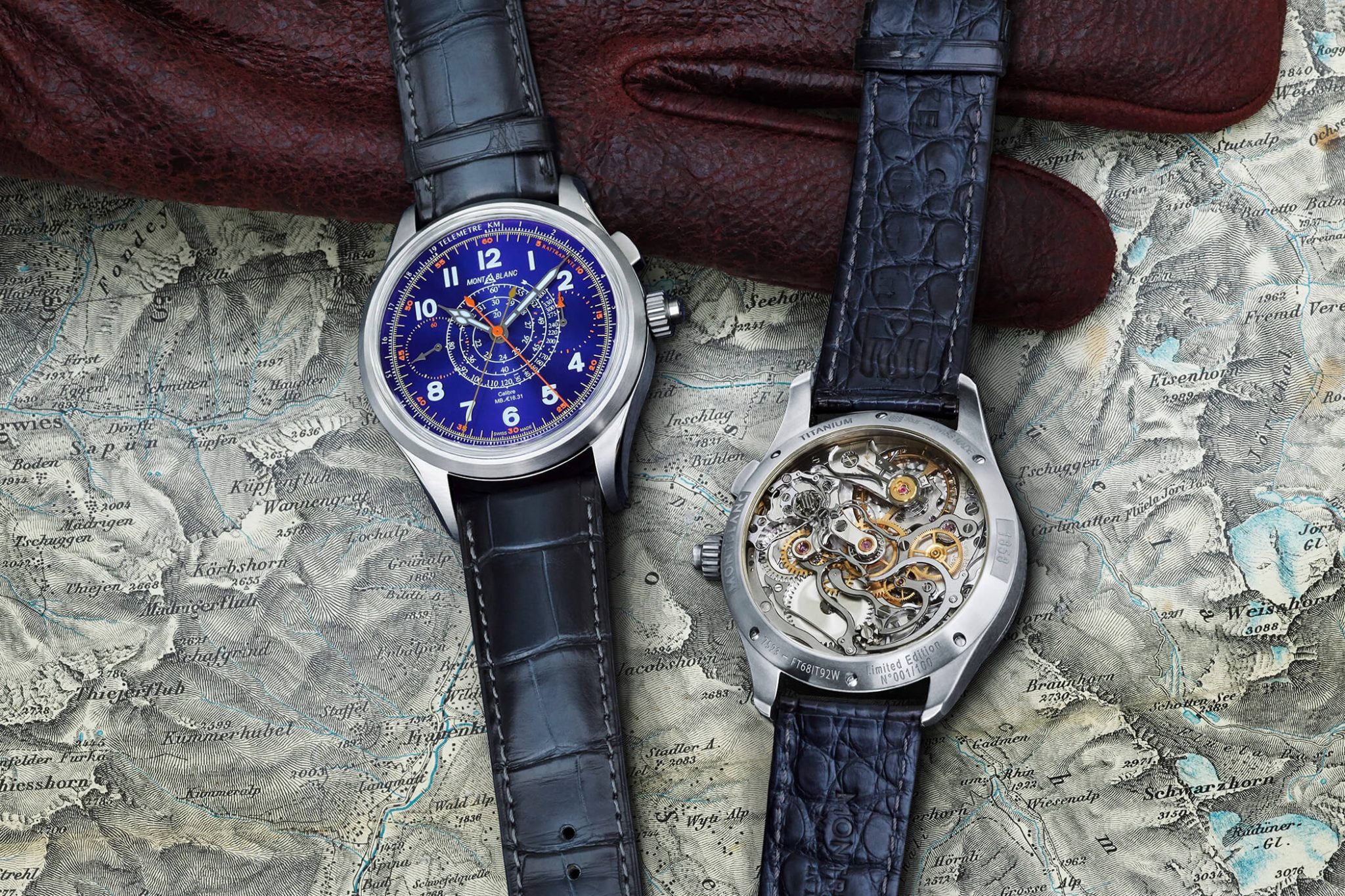
The monopusher split second chronograph calibre MB M16.31
Taking all of this into account, the 1858 Split Second Chronograph Limited Edition 100 is characterised by both classical style and traditional craftsmanship. That said, the vibrant colours and innovative material add a modern touch. With its 44 mm case size, the watch is not as delicate as its vintage-design might look in pictures. Given that it is limited to 100 pieces, it will most likely be fairly rarely seen in public. What’s more, it will probably be snapped up and sold out swiftly by Montblanc enthusiasts – despite the 39,500 euros price tag.
A cosmopolitan creation – Montblanc 1858 Geosphere
At a price varying from 5,600 euros (with a leather strap) to 5,900 euros (with a steel-titanium-bracelet), the 1858 Geosphere is at a completely different price level to the limited split second chronograph. That’s not the only reason why it could become a bestseller. Watches equipped with a world time complication are always popular, –possibly even more so in times in which we dream of relaxing at a faraway beach.
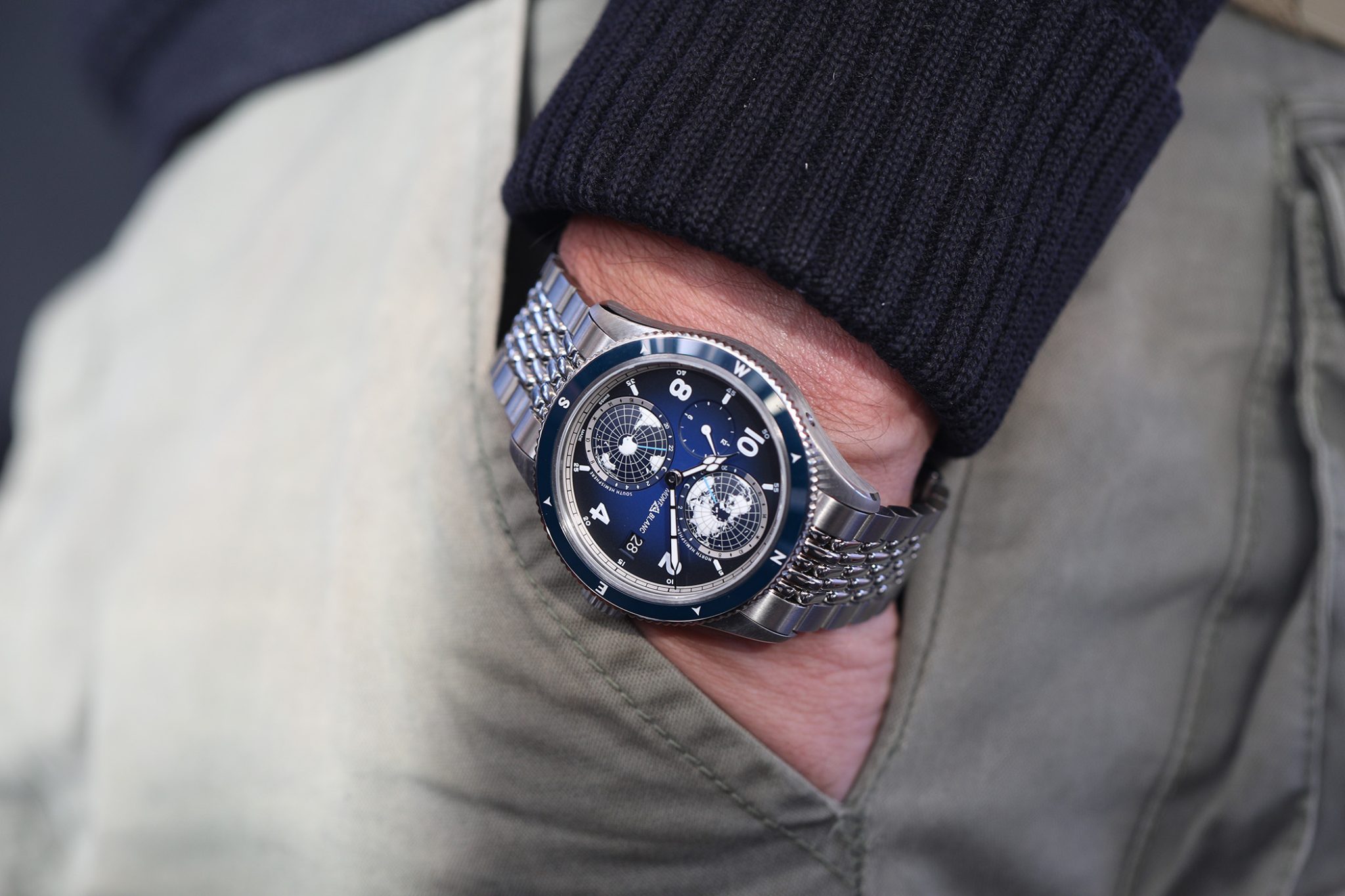
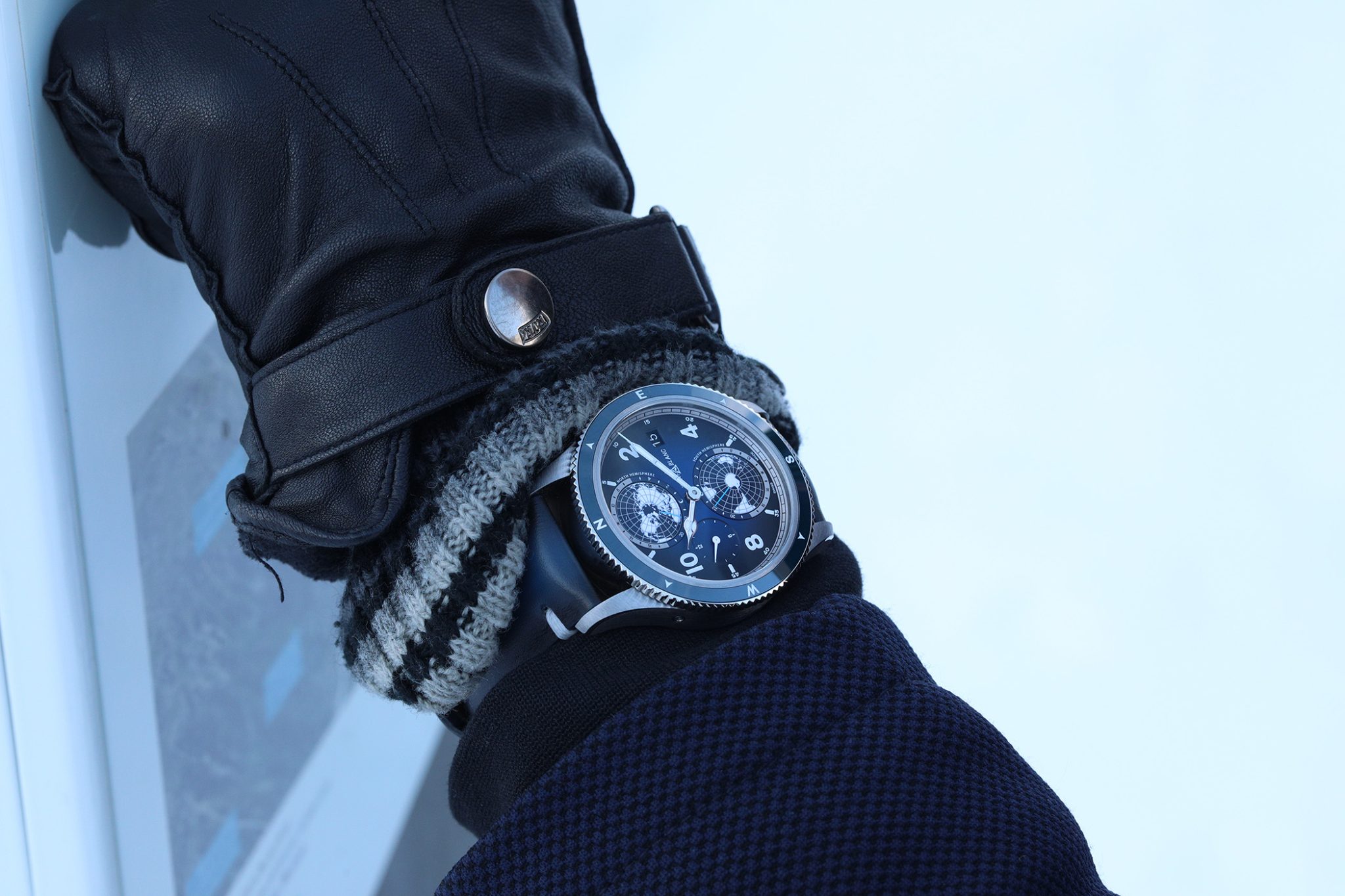
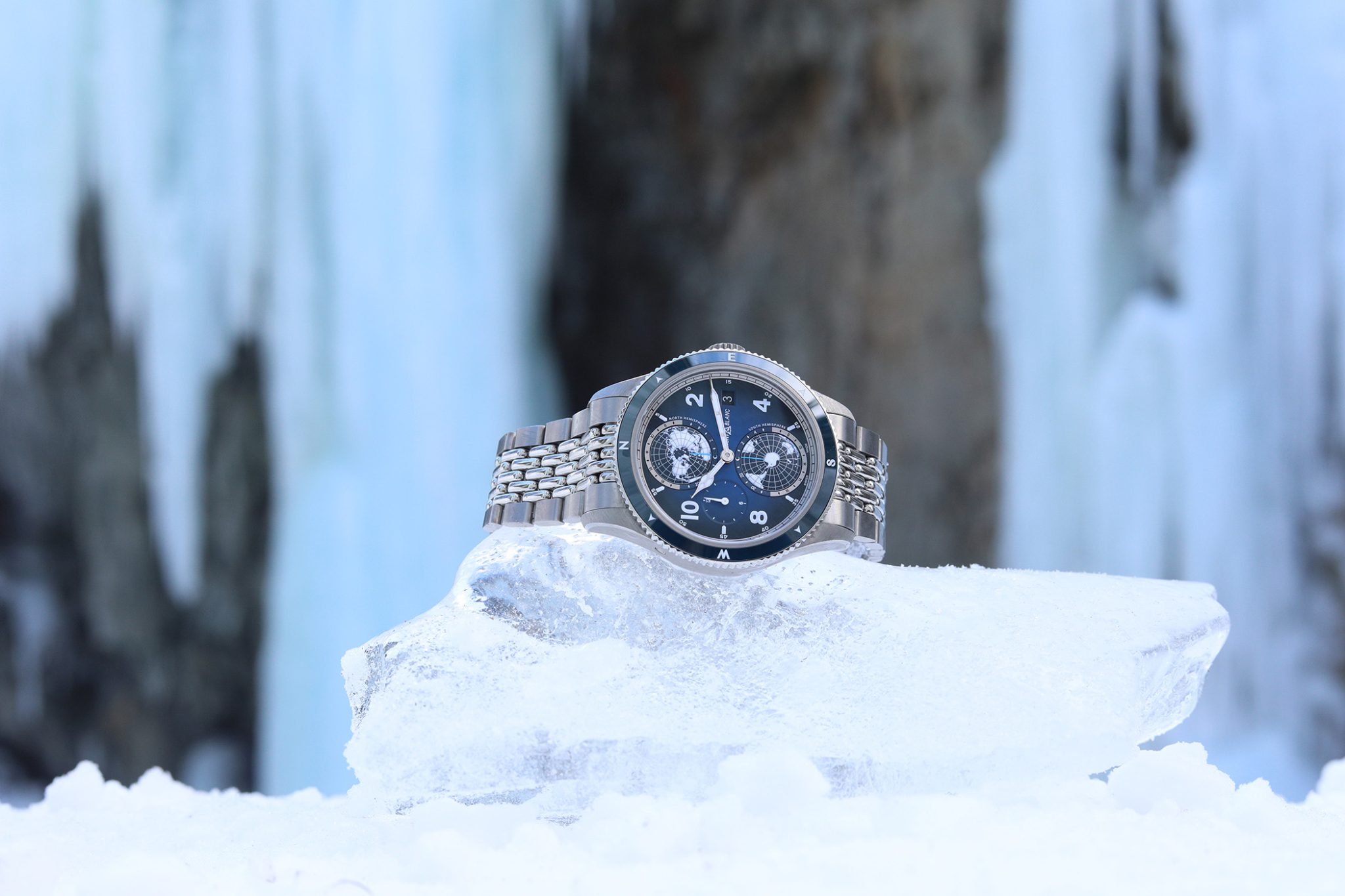
Montblanc 1858 Geosphere with glacier blue dial
Moreover, the Geosphere, with its distinguished displaying of times around the world, has quickly become one of the most recognisable Montblanc models. The latest limited editions – featuring a bronze case and a green or black dial, or an alternative steel version – have already sold very well.
An extra dose of wanderlust
Now, the brand has introduced a titanium version, although the bezel of the new 42 mm watch is made of steel with blue ceramic. The true star of the show for this watch’s design is not the colour or material, but rather the northern and southern rotating globes situated at 12 and 6 o’clock. The Mont Blanc itself, as well as the ‘Seven Summits’ (the highest summits of each continent), are marked with blue dots on the mini globes. The design will no doubt give every globetrotter the feeling that with this watch, they too have taken an extra dose of wanderlust.
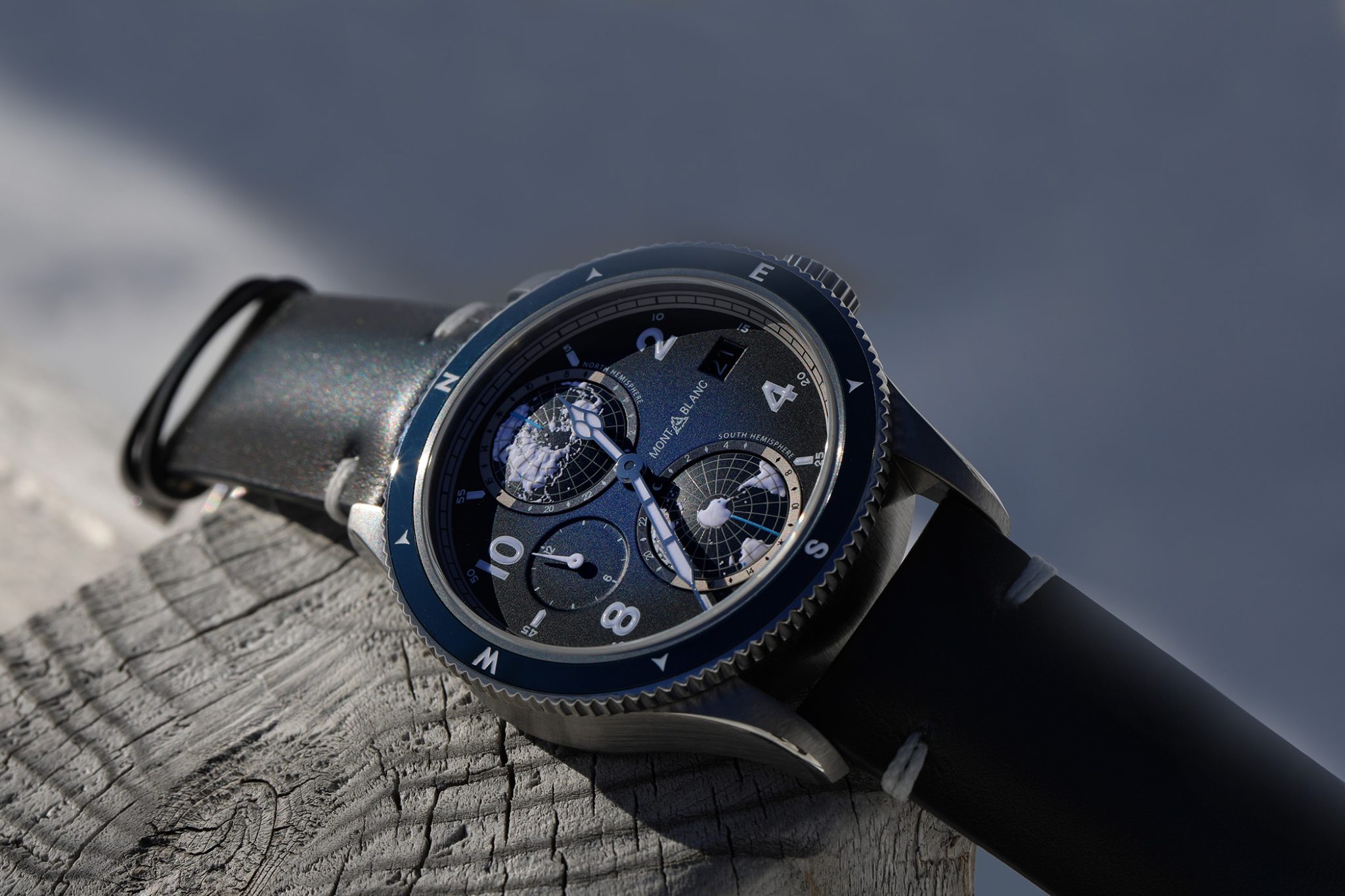
The mini globes show the Seven Summits, marked with tiny blue dots
Moving to the technicalities, the watch can be set by aligning the two hemispheres to London UTC. Both rotating globes are then synchronized and the local time can be set. You can then set a second time at 9 o’clock to indicate the time back home.
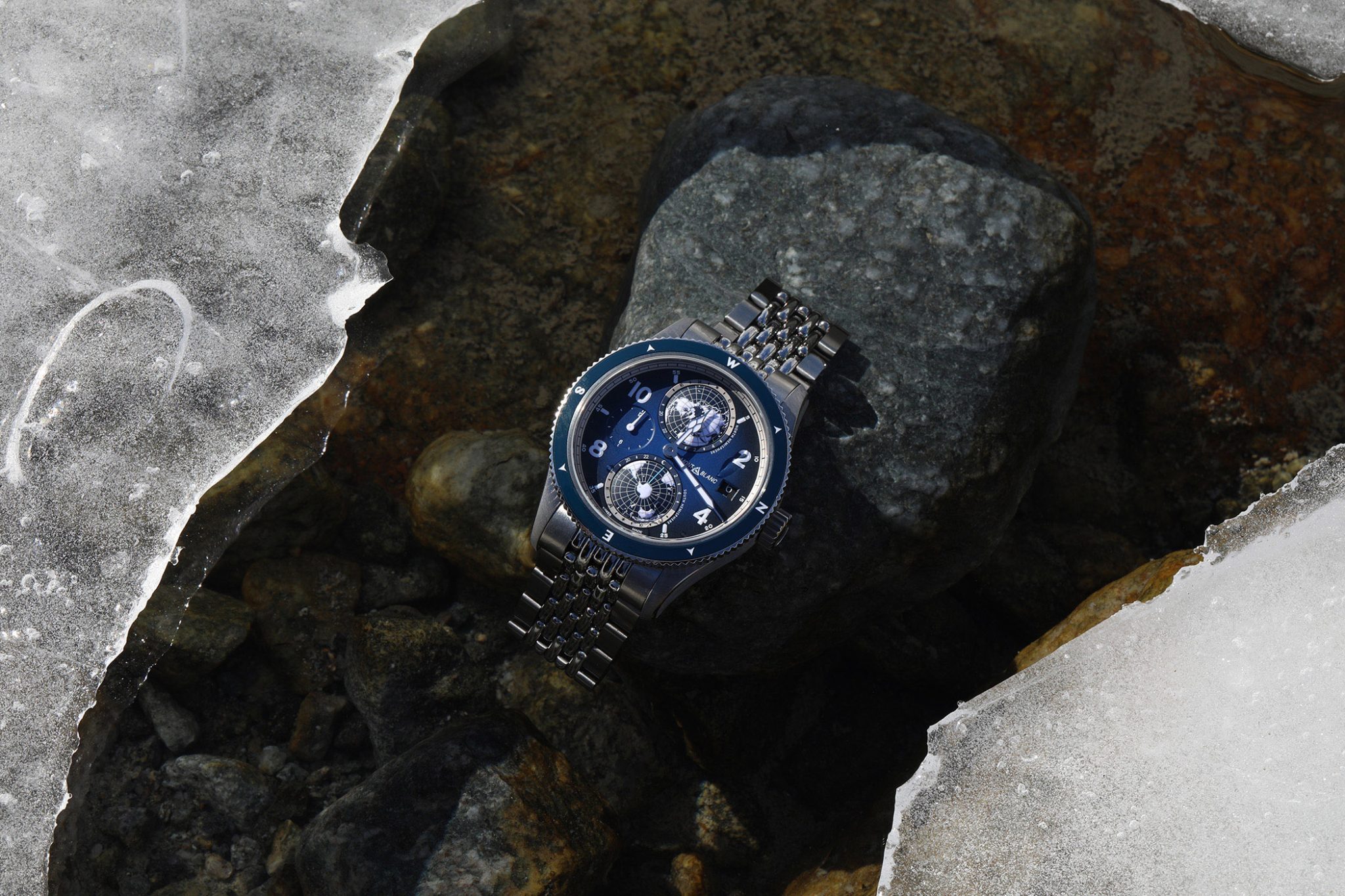
The new 1858 Geosphere is run by the automatic calibre MB 29.25
The dial’s charming miniature universe is run by the automatic calibre MB 29.25 with 42-hour power reserve. However, the movement is hidden underneath a titanium caseback. Nevertheless, the caseback is by no means dull – rather, it reveals an engraving of the Mont-Blanc, a compass and two crossed ice axes.
Spirit of adventure
Even the least experienced mountaineers will question whether the Geosphere really is the perfect watch for climbing challenging summits of 8000 meters or more. However, we do know a few things for sure. Both the 1858 Split Second Chrono and the 1858 Geosphere have gone above and beyond in answering the demand for blue dials with these two particularly appealing models.

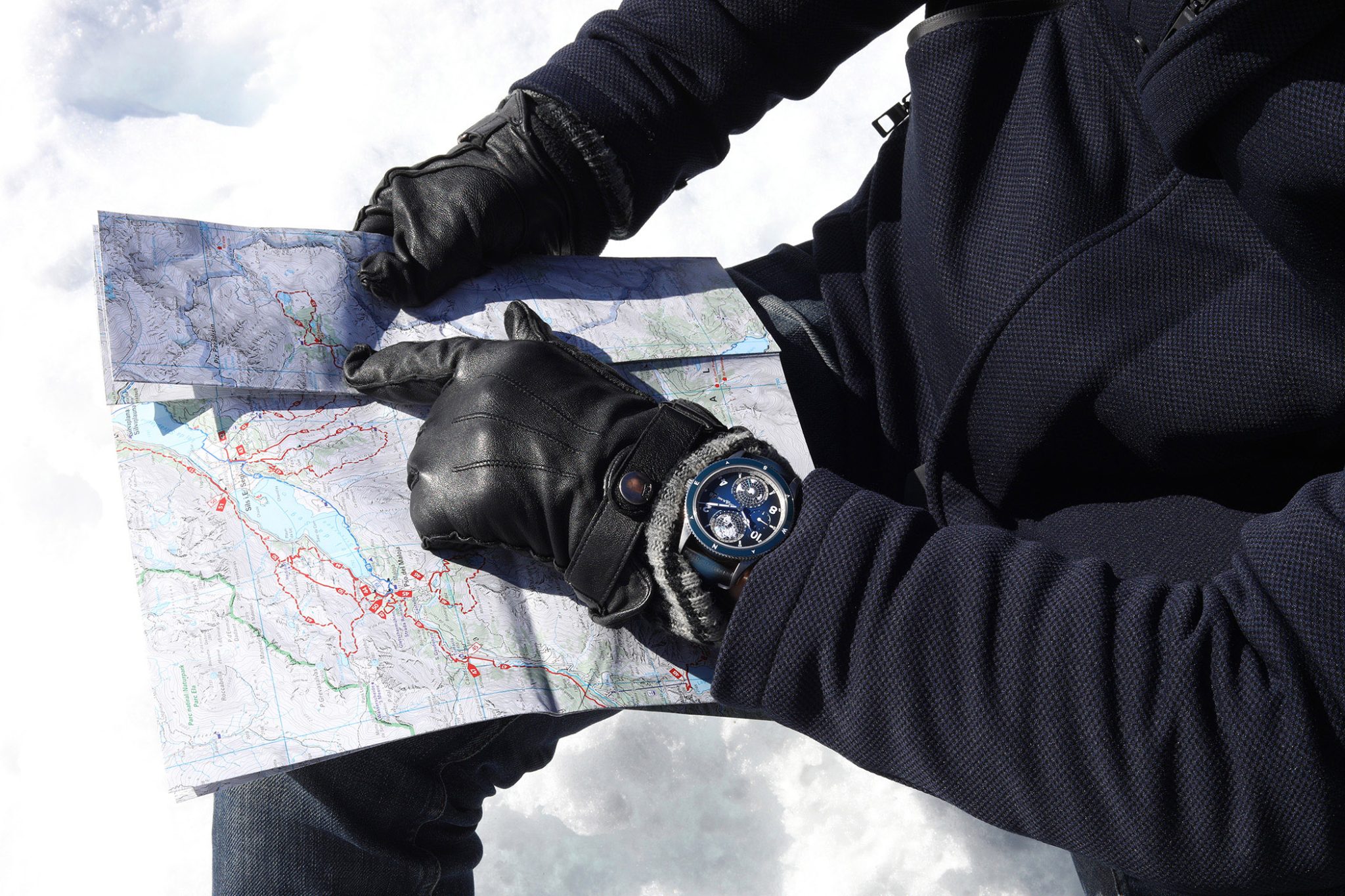
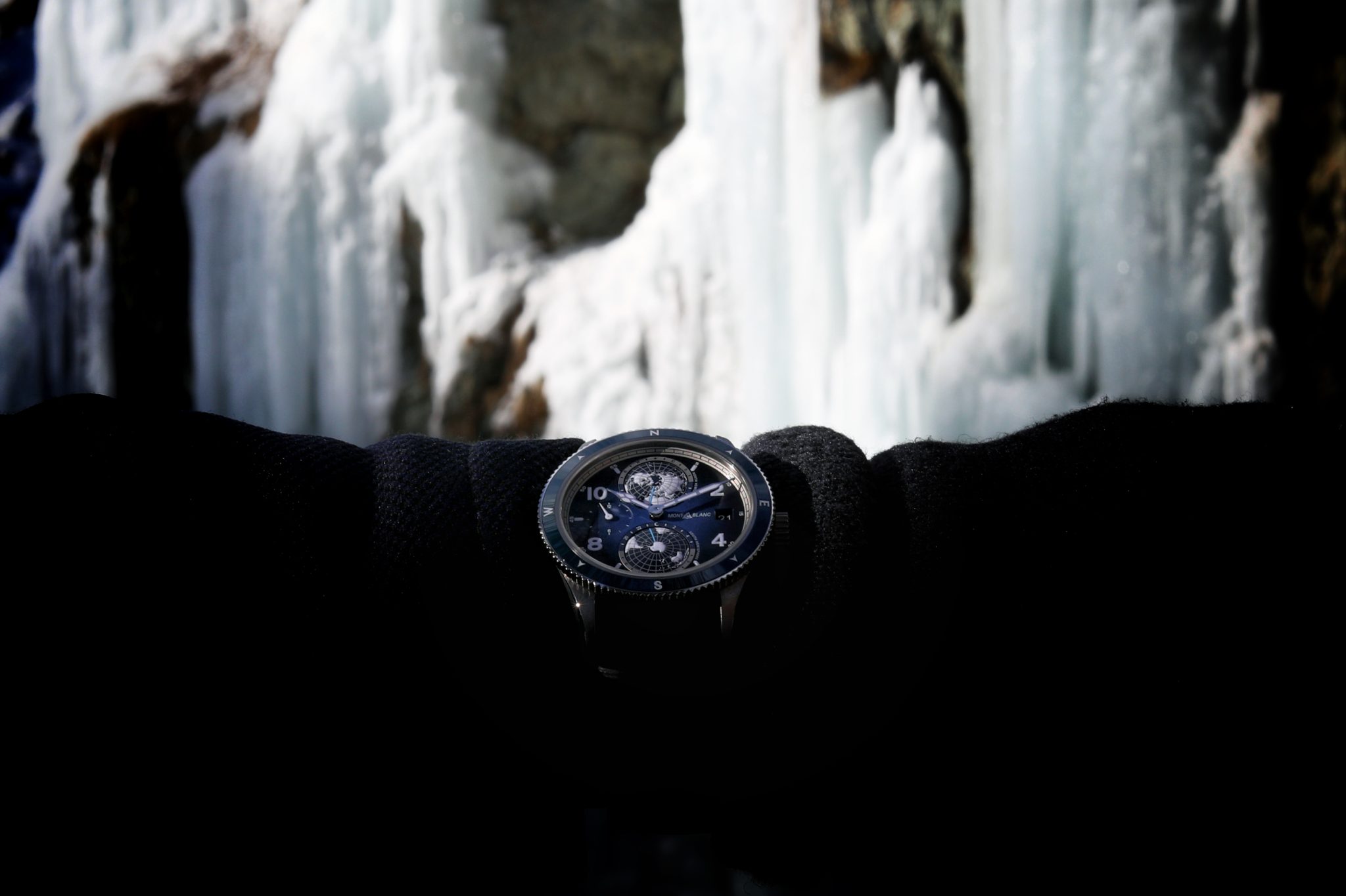
Spirit of Adventure – the 1858 Geosphere in Blue
Both watches are elegant, distinguished and simultaneously exude a feeling of motivation and excitement. The models prepare their adventurous wearers for departure, or even a new start. After all, signalling a departure or a start is what every watch ultimately does, and is what every glance at tone’s wrist triggers. It may be your next appointment. It may simply be the fact that the next minute or even hour is approaching. Or – it may be a reminder that even in these times, we have plans for the future.


